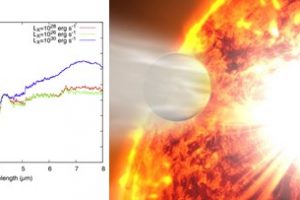Molecules in the atmospheres of exoplanets externally irradiated by UV and X-rays

One of the lessons we have learned after two decades of exoplanetary science, primarily from the diversity of exoplanets discovered to date, is that various properties of exoplanets depend on the characteristics and evolution of their parent stars. Specifically, stellar X-ray and UV radiation can impact the chemical and physical properties of planetary atmospheres. While UV radiation is primarily absorbed by the outer atmospheric layers where the pressure is below 10-6 bar, X-rays can penetrate deeper, reaching pressures of 10-3 -10-2 bar, due to a smaller absorption cross-section (the cross-section is a quantity often used in physics to describe interactions and provides a good estimate of the probability of an interaction to occurr). Additionally, X-ray photons induce intense ionization, injecting high-energy electrons into the atmosphere that can produce a cascade of secondary ionization. These particles are capable of ionizing H2 molecules and generating various ion species in the atmosphere.
The energetic radiation required to induce such effects is emitted by the central stars, generated by the magnetic activity present in almost all stars. Since this activity is intensified by stellar rotation, young stars, which rotate rapidly, are thousands of times brighter in the X-ray and UV bands than older stars with equal mass. Generally, young stars exist in a “saturated” state, where their X-ray luminosity is consistently around one thousandth of the bolometric luminosity (which is the total stellar luminosity integrated across the entire electromagnetic spectrum). Due to these combined factors, a planet orbiting around a young star is consistently exposed to intense UV and X-ray radiation, regardless of the mass of its central star. In fact, while it is true that more massive young stars exhibit higher luminosity in both the bolometric and UV/X-ray regimes, it is also true that in less massive stars, the saturation period lasts longer, resulting in extended exposure of the planets to the energetic radiation emitted by the stellar system.
Is it possible to use modern telescopes, such as the James Webb Space Telescope or, in the near future, Ariel, to observe the effects of UV/X-ray radiation on planetary atmospheres? This is the question that a team of researchers, led by astronomer D. Locci (INAF – Astronomical Observatory of Palermo), has addressed by developing chemical-physical models of atmospheres of gaseous giants irradiated by incident UV/X-ray radiation. Through the synthesis of spectra at different resolutions observed in transmission (e.g., during the transit of planets in front of their stars), the team has demonstrated that modern telescopes could reveal non-equilibrium abundances of molecules, such as carbon monoxide and dioxide, methane, acetylene, and hydrogen cyanide, in highly irradiated planetary atmospheres. These models confirm that, thanks to observations with telescopes such as JWST and Ariel, it will be possible to observe and study the effects of incident X-ray and UV radiation on the properties and evolution of planetary atmospheres. The study is described in the paper titled “Signatures of X-ray dominated chemistry in the spectra of exoplanetary atmospheres,” recently published in The Planetary Science Journal. Among the coauthors are astronomers A. Petralia, G. Micela, A. Maggio, and C. Cecchi-Pestellini from INAF – Astronomical Observatory of Palermo.
The cover figure (click here to view it in its entirety) displays synthetic spectra at low resolution of a transiting exoplanet, calculated assuming an X-ray luminosity of the parent star of 1026 (green line), 1028 (red line), and 1030 erg/s (blue line). The synthetic spectra exhibit an enhancement of signals attributed to molecules such as water, carbon monoxide and dioxide, and methane with increasing stellar X-ray luminosity.
Mario Giuseppe Guarcello ( follow mariospiegacose) ( mariospiegacose) ( follow mariospiegacose)
Follow the Astronomical Observatory of Palermo on Facebok and on Instagram
Subscribe the Youtube channel of the Astronomical Observatory of Palermo
